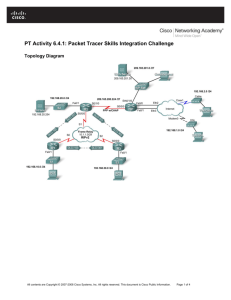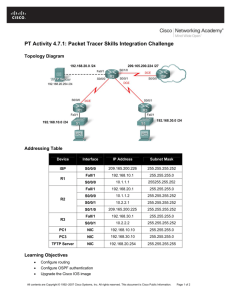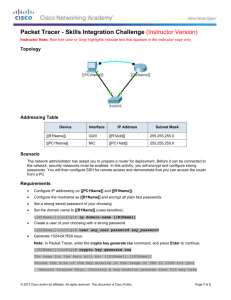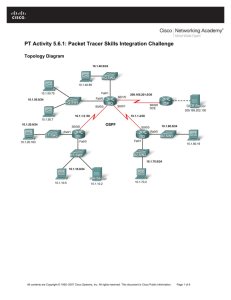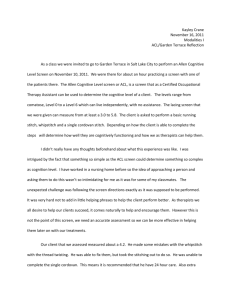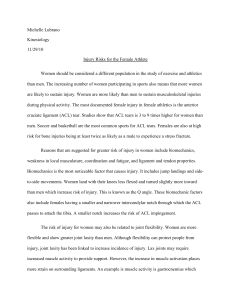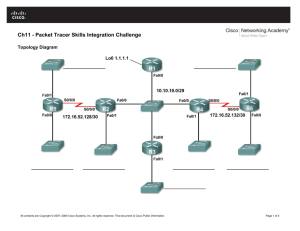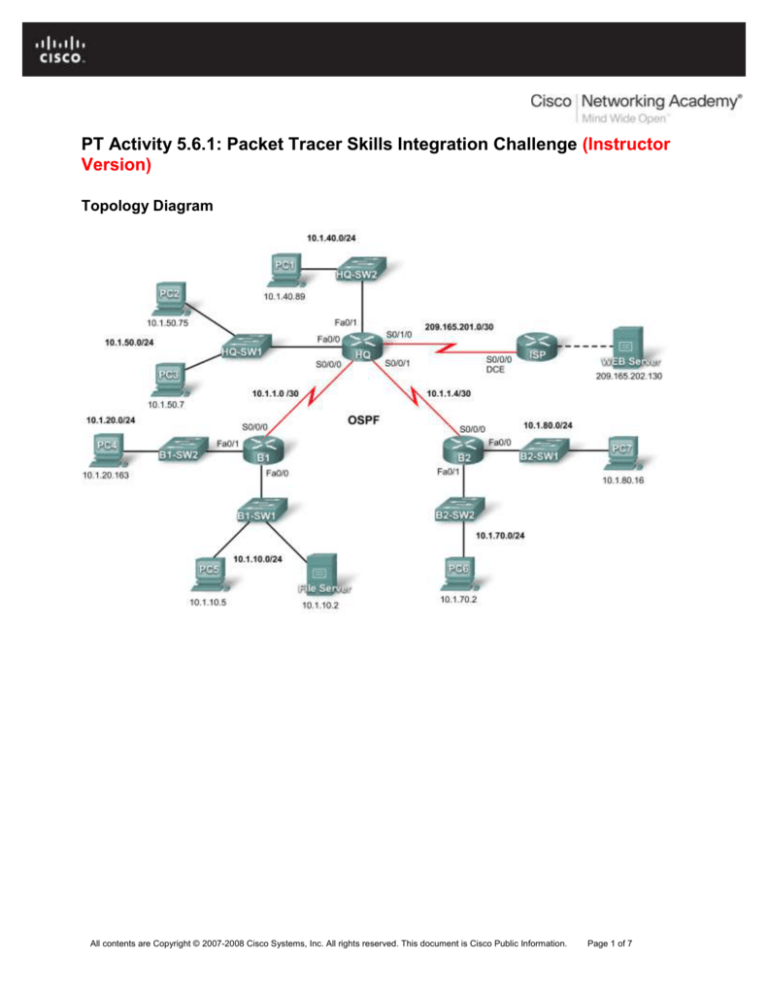
PT Activity 5.6.1: Packet Tracer Skills Integration Challenge (Instructor
Version)
Topology Diagram
All contents are Copyright © 2007-2008 Cisco Systems, Inc. All rights reserved. This document is Cisco Public Information.
Page 1 of 7
CCNA Exploration
Accessing the WAN: ACLs
PT Activity 5.6.1: Packet Tracer Skills Integration Challenge
Addressing Table
Device
Interface
IP Address
Subnet Mask
S0/0/0
10.1.1.1
255.255.255.252
S0/0/1
10.1.1.5
255.255.255.252
S0/1/0
209.165.201.2
255.255.255.252
Fa0/0
10.1.50.1
255.255.255.0
Fa0/1
10.1.40.1
255.255.255.0
S0/0/0
10.1.1.2
255.255.255.252
Fa0/0
10.1.10.1
255.255.255.0
Fa0/1
10.1.20.1
255.255.255.0
S0/0/0
10.1.1.6
255.255.255.252
Fa0/0
10.1.80.1
255.255.255.0
Fa0/1
10.1.70.1
255.255.255.0
S0/0/0
209.165.201.1
255.255.255.252
Fa0/0
209.165.202.129
255.255.255.252
NIC
209.165.202.130
255.255.255.252
HQ
B1
B2
ISP
Web Server
Learning Objectives
Configure PPP with CHAP authentication.
Configure default routing.
Configure OSPF routing.
Implement and verify multiple ACL security policies.
Introduction
In this activity, you will demonstrate your ability to configure ACLs that enforce five security policies. In
addition, you will configure PPP and OSPF routing. The devices are already configured with IP
addressing. The user EXEC password is cisco, and the privileged EXEC password is class.
Task 1: Configure PPP with CHAP Authentication
Step 1. Configure the link between HQ and B1 to use PPP encapsulation with CHAP
authentication.
The password for CHAP authentication is cisco123.
HQ(config)#username B1 password cisco123
HQ(config)#interface s0/0/0
HQ(config-if)#encapsulation ppp
HQ(config-if)#ppp authentication chap
B1(config)#username HQ password cisco123
B1(config)#interface s0/0/0
B1(config-if)#encapsulation ppp
All contents are Copyright © 2007-2008 Cisco Systems, Inc. All rights reserved. This document is Cisco Public Information.
Page 2 of 7
CCNA Exploration
Accessing the WAN: ACLs
PT Activity 5.6.1: Packet Tracer Skills Integration Challenge
B1(config-if)#ppp authentication chap
Step 2. Configure the link between HQ and B2 to use PPP encapsulation with CHAP
authentication.
The password for CHAP authentication is cisco123.
HQ(config)#username B2 password cisco123
HQ(config)#interface s0/0/1
HQ(config-if)#encapsulation ppp
HQ(config-if)#ppp authentication chap
B2(config)#username HQ password cisco123
B2(config)#interface s0/0/0
B2(config-if)#encapsulation ppp
B2(config-if)#ppp authentication chap
Step 3. Verify that connectivity is restored between the routers.
HQ should be able to ping both B1 and B2. The interfaces may take a few minutes to come back up. You
can switch back and forth between Realtime and Simulation mode to speed up the process. Another
possible workaround to this Packet Tracer behavior is to use the shutdown and no shutdown
commands on the interfaces.
Note: The interfaces may go down at random points during the activity because of a Packet Tracer bug.
The interface normally comes back up on its own if you wait a few seconds.
Step 4. Check results.
Your completion percentage should be 29%. If not, click Check Results to see which required
components are not yet completed.
Task 2: Configure Default Routing
Step 1. Configure default routing from HQ to ISP.
Configure a default route on HQ using the exit interface argument to send all default traffic to ISP.
HQ(config)#ip route 0.0.0.0 0.0.0.0 s0/1/0
Step 2. Test connectivity to Web Server.
HQ should be able to successfully ping Web Server at 209.165.202.130 as long as the ping is sourced
from the Serial0/1/0 interface.
Step 3. Check results.
Your completion percentage should be 32%. If not, click Check Results to see which required
components are not yet completed.
Task 3: Configure OSPF Routing
Step 1. Configure OSPF on HQ.
Configure OSPF using the process ID 1.
Advertise all subnets except the 209.165.201.0 network.
Propagate the default route to OSPF neighbors.
Disable OSPF updates to ISP and to the HQ LANs.
All contents are Copyright © 2007-2008 Cisco Systems, Inc. All rights reserved. This document is Cisco Public Information.
Page 3 of 7
CCNA Exploration
Accessing the WAN: ACLs
PT Activity 5.6.1: Packet Tracer Skills Integration Challenge
HQ(config)#router ospf 1
HQ(config-router)#network 10.1.1.0 0.0.0.3 area 0
HQ(config-router)#network 10.1.1.4 0.0.0.3 area 0
HQ(config-router)#network 10.1.40.0 0.0.0.255 area 0
HQ(config-router)#network 10.1.50.0 0.0.0.255 area 0
HQ(config-router)#default-information originate
HQ(config-router)#passive-interface fa0/0
HQ(config-router)#passive-interface fa0/1
HQ(config-router)#passive-interface s0/1/0
Step 2. Configure OSPF on B1 and B2.
Configure OSPF using the process ID 1.
On each router, configure the appropriate subnets.
Disable OSPF updates to the LANs.
B1(config)#router ospf 1
B1(config-router)#network 10.1.1.0 0.0.0.3 area 0
B1(config-router)#network 10.1.10.0 0.0.0.255 area 0
B1(config-router)#network 10.1.20.0 0.0.0.255 area 0
B1(config-router)#passive-interface fa0/0
B1(config-router)#passive-interface fa0/1
B1(config)#router ospf 1
B1(config-router)#network 10.1.1.4 0.0.0.3 area 0
B1(config-router)#network 10.1.70.0 0.0.0.255 area 0
B1(config-router)#network 10.1.80.0 0.0.0.255 area 0
B1(config-router)#passive-interface fa0/0
B1(config-router)#passive-interface fa0/1
Step 3. Test connectivity throughout the network.
The network should now have full end-to-end connectivity. All devices should be able to successfully ping
all other devices, including Web Server at 209.165.202.130.
Step 4. Check results.
Your completion percentage should be 76%. If not, click Check Results to see which required
components are not yet completed.
Task 4: Implement Multiple ACL Security Policies
Step 1. Implement security policy number 1.
Block the 10.1.10.0 network from accessing the 10.1.40.0 network. All other access to 10.1.40.0 is
allowed. Configure the ACL on HQ using ACL number 10.
Use a standard or extended ACL? _______________Standard
Apply the ACL to which interface? _______________Fa0/1
Apply the ACL in which direction? _______________Out
____________________________________________________________________________________
____________________________________________________________________________________
____________________________________________________________________________________
All contents are Copyright © 2007-2008 Cisco Systems, Inc. All rights reserved. This document is Cisco Public Information.
Page 4 of 7
CCNA Exploration
Accessing the WAN: ACLs
PT Activity 5.6.1: Packet Tracer Skills Integration Challenge
____________________________________________________________________________________
____________________________________________________________________________________
HQ(config)#access-list 10 deny 10.1.10.0 0.0.0.255
HQ(config)#access-list 10 permit any
HQ(config)#int fa0/1
HQ(config-if)#ip access-group 10 out
Step 2. Verify that security policy number 1 is implemented.
A ping from PC5 to PC1 should fail.
Step 3. Check results.
Your completion percentage should be 80%. If not, click Check Results to see which required
components are not yet completed.
Step 4. Implement security policy number 2.
Host 10.1.10.5 is not allowed to access host 10.1.50.7. All other hosts are allowed to access 10.1.50.7.
Configure the ACL on B1 using ACL number 115.
Use a standard or extended ACL? _______________Extended
Apply the ACL to which interface? _______________Fa0/0
Apply the ACL in which direction? _______________In
____________________________________________________________________________________
____________________________________________________________________________________
____________________________________________________________________________________
____________________________________________________________________________________
____________________________________________________________________________________
B1(config)#access-list 115 deny ip host 10.1.10.5 host 10.1.50.7
B1(config)#access-list 115 permit ip any any
B1(config)#int fa0/0
B1(config-if)#ip access-group 115 in
Step 5. Verify that security policy number 2 is implemented.
A ping from PC5 to PC3 should fail.
Step 6. Check results.
Your completion percentage should be 85%. If not, click Check Results to see which required
components are not yet completed.
Step 7. Implement security policy number 3.
Hosts 10.1.50.1 through 10.1.50.63 are not allowed web access to Intranet server at 10.1.80.16. All other
access is allowed. Configure the ACL on the appropriate router and use ACL number 101.
Use a standard or extended ACL? _______________Extended
Configure the ACL on which router? ______________HQ
Apply the ACL to which interface? _______________Fa0/0
All contents are Copyright © 2007-2008 Cisco Systems, Inc. All rights reserved. This document is Cisco Public Information.
Page 5 of 7
CCNA Exploration
Accessing the WAN: ACLs
PT Activity 5.6.1: Packet Tracer Skills Integration Challenge
Apply the ACL in which direction? _______________In
____________________________________________________________________________________
____________________________________________________________________________________
____________________________________________________________________________________
____________________________________________________________________________________
____________________________________________________________________________________
HQ(config)#access-list 101 deny tcp 10.1.50.0 0.0.0.63 host 10.1.80.16 eq www
HQ(config)#access-list 101 permit ip any any
HQ(config)#interface fa0/0
HQ(config-if)#ip access-group 101 in
Step 8. Verify that security policy number 3 is implemented.
To test this policy, click PC3, then the Desktop tab, and then Web Browser. For the URL, type in the IP
address for the Intranet server, 10.1.80.16, and press Enter. After a few seconds, you should receive a
Request Timeout message. PC2 and any other PC in the network should be able to access the Intranet
server.
Step 9. Check results.
Your completion percentage should be 90%. If not, click Check Results to see which required
components are not yet completed.
Step 10. Implement security policy number 4.
Use the name NO_FTP to configure a named ACL that blocks the 10.1.70.0/24 network from accessing
FTP services (port 21) on the file server at 10.1.10.2. All other access should be allowed.
Note: Names are case-sensitive.
Use a standard or extended ACL? _______________Extended
Configure the ACL on which router? ______________B2
Apply the ACL to which interface? _______________Fa0/1
Apply the ACL in which direction? _______________In
____________________________________________________________________________________
____________________________________________________________________________________
____________________________________________________________________________________
____________________________________________________________________________________
____________________________________________________________________________________
B2(config)#ip access-list extended NO_FTP
B2(config-ext-nacl)#deny tcp 10.1.70.0 0.0.0.255 host 10.1.10.2 eq ftp
B2(config-ext-nacl)#permit ip any any
B2(config-ext-nacl)#interface fa0/1
B2(config-if)#ip access-group NO_FTP in
All contents are Copyright © 2007-2008 Cisco Systems, Inc. All rights reserved. This document is Cisco Public Information.
Page 6 of 7
CCNA Exploration
Accessing the WAN: ACLs
PT Activity 5.6.1: Packet Tracer Skills Integration Challenge
Step 11. Check results.
Packet Tracer does not support testing FTP access, so you will not be able to verify this policy. However,
your completion percentage should be 95%. If not, click Check Results to see which required
components are not yet completed.
Step 12. Implement security policy number 5.
Since ISP represents connectivity to the Internet, configure a named ACL called FIREWALL in the
following order:
1. Allow only inbound ping replies from ISP and any source beyond ISP.
2. Allow only established TCP sessions from ISP and any source beyond ISP.
3. Explicitly block all other inbound access from ISP and any source beyond ISP.
Use a standard or extended ACL? _______________Extended
Configure the ACL on which router? ______________HQ
Apply the ACL to which interface? _______________S0/1/0
Apply the ACL in which direction? _______________In
____________________________________________________________________________________
____________________________________________________________________________________
____________________________________________________________________________________
____________________________________________________________________________________
____________________________________________________________________________________
HQ(confi)#ip access-list extended FIREWALL
HQ(config-ext-nacl)#permit icmp any any echo-reply
HQ(config-ext-nacl)#permit tcp any any established
HQ(config-ext-nacl)#deny ip any any
HQ(config-ext-nacl)#interface s0/1/0
HQ(config-if)#ip access-group FIREWALL in
Step 13. Verify that security policy number 5 is implemented.
To test this policy, any PC should be able to ping ISP or Web Server. However, neither ISP nor Web
Server should be able to ping HQ or any other device behind the FIREWALL ACL.
Step 14. Check results.
Your completion percentage should be 100%. If not, click Check Results to see which required
components are not yet completed.
All contents are Copyright © 2007-2008 Cisco Systems, Inc. All rights reserved. This document is Cisco Public Information.
Page 7 of 7

